We explore the life and works of the Brothers Grimm, and explain how they collected their stories. In addition, we discuss their significance in the study of folklore.
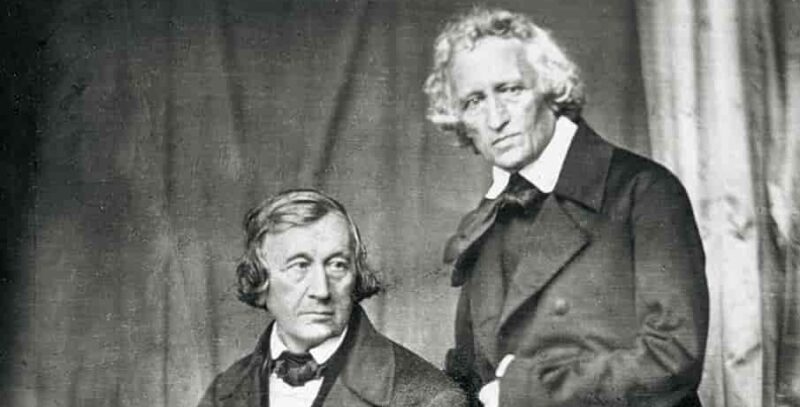
Who were the Brothers Grimm?
Jacob and Wilhelm Grimm, known as the Brothers Grimm, were two eminent German philologists and scholars of folklore who collected and published one of the most famous collections of traditional European oral tales in the 19th century: Children's and Household Tales (Kinder- und Hausmärchen), from which most modern fairy tales originate.
This anthology, comprising about 200 tales gathered by the Grimms and first published in two volumes in 1812 and 1815, has been widely celebrated throughout history. In fact, it has been translated into more than 100 languages and has been adapted numerous times for film and animation, notably by the popular American animation company founded by Walt Disney (1901-1966).
However, this volume is not the only contribution of the Brothers Grimm to Western culture. They also established a method for collecting and analyzing popular folktales which was key in the study of folklore, and published a vast amount of linguistic and literary works. They are therefore regarded as the fathers of Germanic philology.
- See also: Virginia Woolf
Birth and education of the Brothers Grimm
The brothers Jacob and Wilhelm Grimm were born in Hanau, in the province of Hesse, on January 4, 1785 and February 24, 1786 respectively. They were the eldest of five children born to lawyer Phillip Grimm and his wife Dorothea. The small age difference between Jacob and Wilhelm fostered a deep and affectionate lifelong relationship.
Raised in a bourgeois family, their childhood was not without hardships. Their father, a civil servant in the town of Hanau, was transferred to Steinau, another town in the region. In 1796, Phillip died, leaving the family in financial difficulties.
Despite these challenges, the Brothers Grimm proved to have academic talent and vocation. They began their studies at the middle school in the city of Kassel, where they moved with their mother, and later continued their education at the University of Marburg, which they entered with the purpose of following in their father's footsteps and studying law.
While In Marburg, not only did they complete their studies, but they also became acquainted with poet and playwright Clemens Brentano (1778-1842) and jurist and historian Friedrich Karl von Savigny (1779-1861). From them they learned, respectively, the Romantic passion for popular culture and a methodology of textual research that would be crucial in their later work with folklore. Nevertheless, rather than being purely Romantics, the Grimms always maintained a forward-thinking realistic mindset.
In 1805, before completing his studies, Jacob had the opportunity to study with Savigny in Paris, dedicating himself to the study of medieval manuscripts. This allowed him to engage, along with his brother, in the task of collecting popular poems, commissioned by Brentano in 1806. This experience would prove to be of great professional value for both of them.
That same year, the Napoleonic troops invaded Germany. What ensued was a period of significant political and cultural changes, which coincided with the death of the Grimms' mother, Dorothea, in 1808. At just 23 years old, Jacob became the guardian and provider for the family.
The Grimms' collaboration in the project of Clemens Brentano and fellow writer Achim von Arnim (1781-1831) enabled the latter to publish, between 1806 and 1808, the three volumes of The Boy's Magic Horn (Des Knaben Wunderhorn): a collection of German popular folk songs and poems. This anthology later inspired many German classical composers (such as Mendelsohn, Brahms, Schumann, or Mahler) and was an important precursor to the work of the Brothers Grimm.
The beginning of a vocation
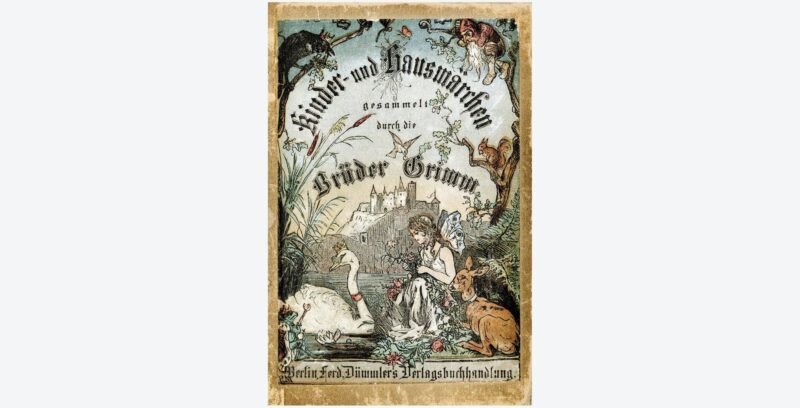
The years of the Napoleonic domination of Germany brought about significant changes for the Grimm family. Jacob found employment in 1808, initially as a private librarian to Jérôme Bonaparte (1807-1813), King of Westphalia and brother of the French Emperor. The following year, he was hired as auditor to the Imperial State Council, a position he held until Napoleon's defeat in 1813.
Wilhelm, in turn, returned home in 1808 after completing his studies. Suffering from asthma and a heart condition, he was unable to find steady employment until 1814. In 1809, he underwent a series of medical treatments to improve his health, moving temporarily to the German city of Halle.
The Battle of Leipzig in 1813 marked the beginning of the withdrawal of French forces from Germany and the emergence of a new national and international order. Jacob found employment as Secretary of Legation, negotiating the return of artworks looted from the German provinces of Hesse and Prussia, and the following year he served in the Congress of Vienna (1814-1815). Meanwhile, Wilhelm secured a position in the Library of the Electorate of Hesse, where Jacob joined him in 1816.
The return to normalcy convinced the Grimms that their interest in law was a thing of the past. From then on, their efforts focused exclusively on the world of books and culture. Encouraged by their friends Brentano and von Arnim, they embarked on the task of collecting folktales that initially aimed to gather stories not only from Germany but also from Spain, Scandinavia, Great Britain, Finland, the Netherlands, and even Serbia.
For the Brothers Grimm, this type of tales represented the true human and universal stories, capable of expressing the deep values of European culture. Nevertheless, the Grimms' approach to these folk stories distanced itself from a beautifying Romantic view, assuming instead the commitment to give them a definitive form without altering their values and popular essence. In this sense, their aspiration was a scientific approach to folklore.
Children's and Household Tales
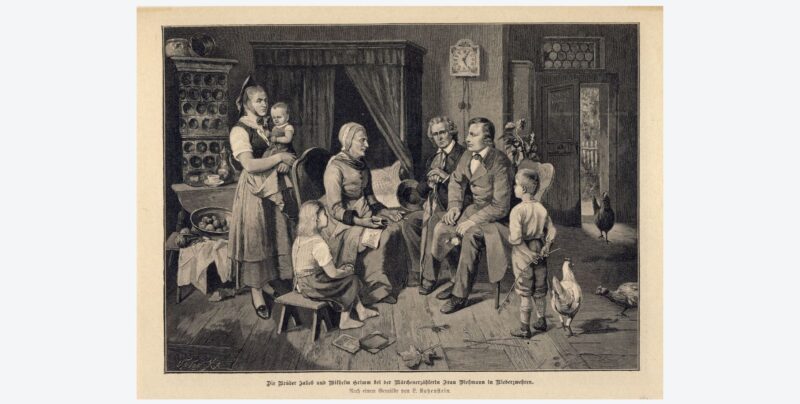
The first edition of the Brothers Grimm's Children's and Household Tales was published in 1812, comprising 86 stories from German and European tradition. In 1815, they published the second volume, adding 70 new stories to the project, sourced from various German storytellers, particularly from Dorothea Viehmann (1755-1816), a renowned storyteller of traditional tales. This volume also included stories from earlier publications by Charles Perrault (1628-1703), Johann Karl August Musäus (1735-1787), and Benedikte Naubert (1752-1819).
In 1816, the brothers embarked on a new project strictly of German stories and legends entitled German Legends (Deutsche Sagen), which was completed in 1818 and met with little success. Thereafter, they continued to work on the second (1818) and third (1822) editions of Children's and Household Tales (Kinder- und Hausmärchen, or KHM from the German acronym), in which they revised and expanded the collection to a total of 170 tales.
Subsequent editions were released in 1837, 1840, 1843, 1850, and 1857, in which stories were added and removed, eventually reaching a total of 210 fairy tales. All editions were illustrated, initially by Johann Philipp Groot and later by Robert Leinweber.
The early editions of KHM received positive reviews, though they also met with criticism due to the violent nature of the stories (especially regarding retribution against villains) and certain sexual innuendos deemed inappropriate for children at the time.
As a result, in subsequent re-editions and versions, the tales compiled by the Brothers Grimm were altered and softened to better align with contemporary sensibilities. Thus, for example, in 1825 Small edition (Kleine ausgabe) appeared, a third collection of 50 fairy tales by the Brothers Grimm intended for children. This volume was so successful that ten successive editions were published between its release and 1858.
Göttingen Seven
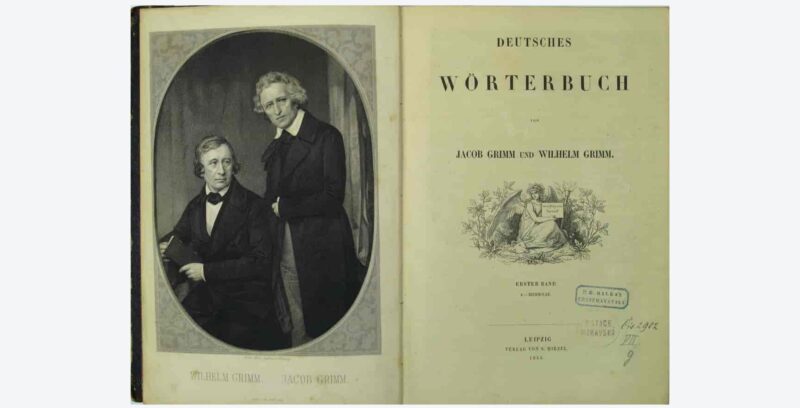
When opportunities in Kassel came to an end for the brothers, they decided to move to the city of Göttingen, in the German kingdom of Hanover, where they found employment first as librarians and later as professors. Many of their major contributions to German culture and language were made during this period.
Such was the case with the Dictionary of the German Language (Deutsches Wörterbuch), a project they began in 1838, publishing its first volume in 1854. This was the first and most important dictionary of the German language, whose thirty-two volumes were not completed until 1961, over a century after the Grimm brothers initiated the project.
Jacob, in addition, made substantial contributions to the field of Germanic philology, notably with his Deutsche Grammatik (German Grammar), the first known study of the historical development of the Germanic languages. Produced between 1819 and 1837, this work formulated the laws of sound change in different languages (both for vowels and consonants), laying the groundwork for scientific etymology and what later became known as Grimm's Law.
These were pioneering publications of great importance for the linguistic study of Germanic, Latin, and Slavic languages. They were complemented with translations of Serbian grammar by Vuk Stefanović Karadžić (1787-1864), a scholar and friend of Jacob's, and later by a study on the ancient practices, laws, and beliefs of the Germanic people that Jacob published in 1828 under the title Deutsche Rechtsaltertümer (German Legal Antiquities).
In Germanic linguistics, "Grimm's Law" (or the First Germanic Consonant Shift) refers to a phenomenon of linguistic transformation that occurred in the history of Germanic and Armenian languages around the 1st century BC. This phenomenon involved the transformation of certain inherited Indo-European sounds (voiceless and voiced stop phonemes), so that they continued to be articulated at the same point in the mouth but in a completely different manner.
Wilhelm, in turn, devoted himself to the study of European literary tradition during his years in Göttingen. He published books about the Danish songs of heroic deeds and German heroic legends, and in 1835 his Deutsche Mythologie (German Mythology), a profound and influential study on the subject.
In 1825, Wilhelm married Henrietta Dorothea Wild, a young woman originally from Kassel, with whom he had four sons: Jacob (born and died in 1826), Herman (1828-1901), Rudolf (1830-1889), and Auguste (1832-1919). Jacob remained a bachelor, dedicating himself to his travels and fieldwork throughout France, Holland, Belgium, Switzerland, Austria, Italy, Denmark, and Sweden.
In 1837, their days in Göttingen came to an end, when the new king of Hanover, Ernest August I (1771-1851), attempted to annul the existing liberal constitution, sparking protests from intellectuals, especially from university professors. Summoned by historian and politician Friedrich Christoph Dahlmann (1785-1860), the Grimms joined four other professors and signed a letter of protest addressed to the king refusing to swear an oath of allegiance.
The consequences were immediate: the signatories were dismissed from the university, and three of them, including Jacob, were expelled from the Kingdom of Hanover. For their actions, this group of university professors became known as the Göttingen Seven.
Life in Prussia and their last days
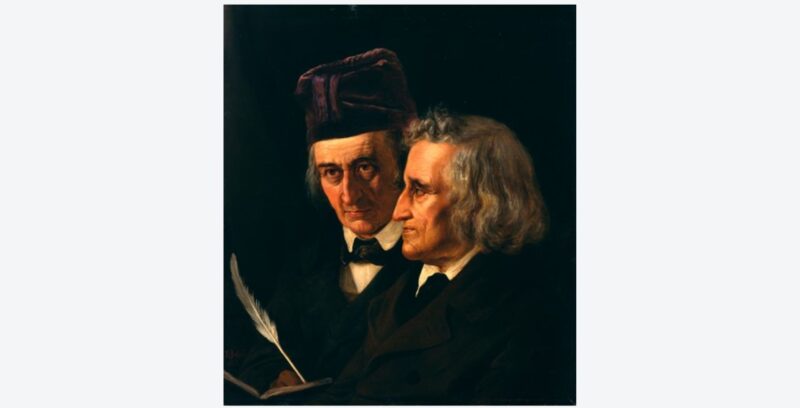
In 1837, the Grimms returned to Kassel, living there for three years, during which time they received numerous invitations from German universities in Hamburg, Marburg, Weimar, and Rostock, and even from institutions abroad in France, Belgium, and Switzerland. Their actions in Göttingen had earned them respect and recognition in the academic community.
In 1840, King Frederick William IV of Prussia (1795-1861) invited them to join the Royal Academy of Sciences in Berlin. There, they were able to dedicate themselves fully to their ambitious dictionary project, which would include all the words of the German language since the time of Martin Luther, along with their historical variants and etymological explanations. Shortly after, they obtained positions at Humboldt University.
For 20 years, the Grimms lived in the German Kingdom of Prussia, where they undertook other important projects like Geschichte der deutschen Sprache (History of the German Language), published by Jacob in 1848, among many other unique scholarly works collected under the title Kleinere Schriften (Minor Writings). Their fame in the European academic world was enormous, and many universities took pride in having them as collaborators.
While in Berlin they witnessed the Revolutions of 1848, and Jacob became a member of the Frankfurt parliament. Wilhelm died on December 16, 1859, and was buried in the Old St. Matthew's Churchyard in Berlin. His brother Jacob died on September 20, 1863. Following their deaths, they received honors and tributes from the German people.
Legacy of the Brothers Grimm
The extensive work of the Brothers Grimm is a cornerstone of the study of German language and culture, as well as of the scientific study of folklore. Their method of collecting and analyzing traditional tales has been imitated by scholars in other countries, and their work on the German language dictionary inspired similar projects in England and France. They are thus considered among the foremost scholars of their time.
Internationally, their most renowned work is their collection of traditional tales, many of which have survived to the present day in versions more or less faithful to the original and translated into over 100 languages. They have also been adapted to various artistic forms, constituting an important heritage of contemporary Western children's imagery thanks to popular reworkings such as those by Walt Disney Pictures.
Among the most famous folktales collected by the Brothers Grimm are:
- Sleeping Beauty (Dornröschen)
- Snow White (Schneewittchen)
- Little Red Riding Hood (Rotkäppchen)
- Cinderella (Aschenputtel)
- The Golden Goose (Die goldene Gans)
- Hansel and Gretel (Hansel und Gretel)
- The Wolf and the Seven Little Goats (Der Wolf und die sieben jungen Geißlein)
- The Frog Prince (Der Froschkönig)
- Tom Thumb (Daumesdick)
- Rapunzel (Rapunzel)
- Rumpelstiltskin (Rumpelstilzchen)
- The Brave Little Tailor (Das tapfere Schneiderlein)
References
- Esteban, A. (2007). “Los hermanos Grimm: sus investigaciones en las bibliotecas alemanas”. Mi biblioteca, año 3, n° 9, pp. 116-119.
- Denecke, L. (2023). “Grimm Brothers”. The Encyclopaedia Britannica. https://www.britannica.com/
- Hernández, I. (2023). “Hermanos Grimm, los coleccionistas de cuentos”. National Geographic. https://historia.nationalgeographic.com.es/
- Selfa Sastre, M. y Azevedo, F. (2015), “Siete cuentos inéditos traducidos al español de los Hermanos Grimm: ejemplo de relatos poco moralizantes”. G. Bazzocchi, P. Capanaga, R. Tonin (eds.), Perspectivas multifacéticas en el universo de la literatura infantil y juvenil. MediAzioni.
Explore next:
Was this information useful to you?
Yes NoThank you for visiting us :)